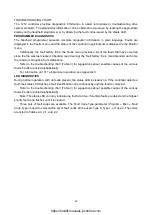
36
TROUBLESHOOTING CHART
The 1212 controller provides diagnostics information to assist technicians in troubleshooting drive
system problems. The diagnostics information can be obtained in two ways: by reading the appropriate
display on the handheld programmer or by observing the fault codes issued by the status LED.
PROGRAMMER DIAGNOSTICS
The handheld programmer presents complete diagnostic information in plain language. Faults are
displayed in the Faults menu, and the status of the controller inputs/outputs is displayed in the Monitor
menu.
Additionally, the fault history file in the Faults menu provides a list of the faults that have occurred
since the file was last cleared. Checking (and clearing) the fault history file is recommended each time
the vehicle is brought in for maintenance.
Refer to the troubleshooting chart (Table 3) for suggestions about possible causes of the various
faults. Faults are listed alphabetically.
For information on 1311 programmer operation, see Appendix C.
LED DIAGNOSTICS
During normal operation, with no faults present, the status LED is steadily on. If the controller detects a
fault, the status LED flashes a fault identification code continuously until the fault is corrected.
Refer to the troubleshooting chart (Table 3) for suggestions about possible causes of the various
faults. Faults are listed alphabetically.
Note: The status LED can only indicate one fault at a time. If multiple faults are detected, the highest
priority fault code flashes until it is cleared.
Three sets of fault codes are available. The Fault Code Type parameter (Program » Misc » Fault
Code Type) is used to select which set of fault codes will be used: Type 0, Type 1, or Type 2. The codes
are listed in Tables 2-0, 2-1, and 2-2.
https://forklift-manuals.jimdofree.com

































